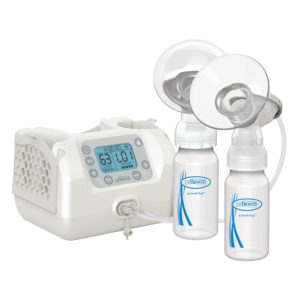Let’s talk about schedules! Everyone loves a schedule, except for newborn babies. It’s a tough transition for them, coming into this world. Think about it: your newborn was inside of you for nine months, connected via the placenta, feeding around the clock. Naturally, when babies come to the earthside, they just want to eat and be all the time. We adults can get frustrated and exhausted, but I am here as an International Board Certified Lactation Consultant (IBCLC) to tell you this is okay, and this is normal, especially during the first six weeks of postpartum. Here, we’ll discuss how to create a breastfeeding or pumping schedule that works for you. (Every family is different; if you want to incorporate formula into your schedule, see here for more information.)
Go With the Flow in the Early Weeks
During the first six weeks after the baby is born, I encourage parents to slow down and embrace this period of major transition for both parent and baby. During this time, we want our bodies to heal, and we want to bond with our baby and build up a great milk supply. This looks like a lot of skin-to-skin contact around the home, lying in bed, and a lot of feeding on demand. Those first six weeks are so crucial for building a strong foundation for your breast milk supply because your hormones are at an all-time high.
From my experience, moms that feed their babies “on demand” and do not start a scheduled routine right away are usually the most successful with having an ample breast milk supply. What does feeding on demand look like? It’s simple: baby starts giving you feeding cues to eat, so you feed the baby. It encourages you to watch your baby instead of the clock. All babies eat about 8-12 times a day. When feeding on demand, it will feel like babies are eating all the time during the day. Generally, this is a good thing (and remember that it’s temporary, parents will sleep again!). We want babies to consume the bulk of their calories during the day. This technique will likely start giving you slightly longer stretches at night when you feed them on demand vs. on a strict schedule. Remember, sleep is part of the feeding equation!
For example, if you feed your baby on a schedule for, let’s say every three hours, your baby will wake up overnight and throughout the day every three hours. But if you feed on demand, your baby might eat every two or three hours during the day, then give you a four- or five-hour stretch of sleep at night. This will still equal the expected eight to 12 feedings in a 24-hour period. Many parents prefer that flexible day with extra nighttime sleep, instead of a strict 24-hour schedule, in those early weeks.
So When Should I Start Working on My Breastfeeding Schedule?
Understand that I use the word “schedule” very lightly. Over those first six to eight weeks, you will start seeing babies get into a rhythm and a schedule of their own. After that time, feeding schedules start becoming more predictable. Also, parents learn to recognize their needs much more clearly. A lot of the parents I work with use an app to track feedings and sleep patterns.
Around this time, we can also start to predict their feedings. For example, if baby feeds around 7 a.m., we may be able to predict that, two or three hours from that time, baby will be hungry again. When you start to see these general patterns in your baby’s feeding needs, you can start to sketch out your own “schedule” to account for these now-predictable feedings.
How Do I Know How Often to Pump During the Day When I Am Away From My Baby?
As a guideline, I recommend that whenever a baby is taking a bottle, the breastfeeding parent should be pumping at the same time. When breastfeeding parents go to work while away from their babies, I encourage them to pump at least every three hours, if possible.
For example, if you are away from the baby for eight hours, it is recommended that you pump at least two times. This will help maintain your milk supply while you are away from your baby.
How Much Breast Milk Will the Baby Take per Bottle While I Am Away?
Generally, breast milk-fed babies eat about every two or three hours during their first year of life, and they take between 1 ounce to 1.5 ounces of breast milk for every hour since they last fed. For example, if your baby is eating every three hours, I recommend giving a bottle with 3 ounces to 4.5 ounces of breast milk.
How Do I Manage Nursing and Pumping While I Am Home With My Baby?
Most of the breastfeeding parents I work with aim to continue to nurse their baby while they are home together (in the morning, evenings, and on weekends). Nursing your baby while you are with them and only pumping when you are away does work for many parents. If parents want to build a little “work stash” of breast milk, I encourage them to pump one more time in addition to feeding their baby at the breast. Some parents fit in another feeding right before they go to bed or after the morning feed.
Here is a sample schedule for a working breastfeeding parent who’s away from baby from 9 a.m. until 5 p.m.:
- 6 a.m.- Breastfeed
- 8 a.m.- Breastfeed at “drop off” or when caregiver arrives
- 10 a.m.- Pump
- 1 p.m.- Pump
- 4 p.m.- Pump
- 6 p.m.- Breastfeed
- 7:30 p.m.- Breastfeed at bedtime
- 10:30 p.m.- Pump/breastfeed during the night as needed
Remember, if you are ever struggling to set up a routine or to remove enough milk with a pump, you can reach out to an IBCLC for help. Many insurance companies now provide lactation coverage, often for up to six visits. Breastfeeding and pumping can be hard work, and teaming up with a lactation consultant can help make your life easier.
About the author:
Leana L. Thompson, RN, BSN, IBCLC
Leana is a Registered Nurse, an International Board Certified Lactation Consultant, and a mom of two little girls under age 2. She lives in Gilbert, Arizona, where she owns her own business, LactationNow. She worked as a Mother-Baby RN for nearly a decade in hospitals all across the United States. Leana offers in-home and virtual lactation consultations. LactationNow’s goal is to provide services that give you and your partner the ultimate mother-baby experience before and after you leave the hospital. She covers prenatal breast consults, weaning consults, and everything in between. She also shares pumping and breastfeeding tips and tricks on her social media (@lactationnow) to support families across the globe. Contact Leana at Leana@lactationnow.com for virtual or in person IBCLC support.


